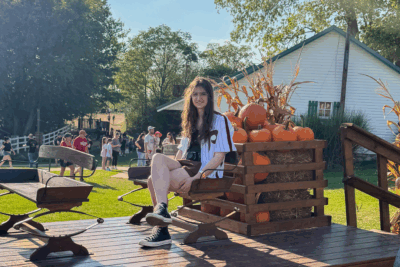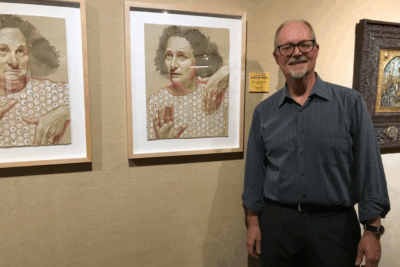One hundred fifty teachers and administrators gathered in the Fellowship hall on Friday and Saturday to learn about the Science of Reading (SoR), an interdisciplinary body of research focused on reading development and teaching methods. The summit sessions were led by Dr. Elsa Cárdenas-Hagan, a bilingual speech language pathologist.
Goshen College became a part of the Advancing Science of Reading in Indiana (ASRI) initiative after receiving a $489,915 grant from Lilly Endowment Inc. in January 2024. The initiative was created in 2022 to enhance Indiana student reading proficiency through SoR instructional methods.Kathy Meyer Reimer, chair of the education and deaf studies department, led the planning and organizing of the summit this year.
“There’s a lot of people talking about the Science of Reading in the state right now. We didn’t want to do the same thing that was happening in other places, so we decided we were going to focus on the English learner,” Meyer Reimer said.
During workshop preparation, Meyer Reimer learned about Dr. Cárdenas-Hagan after reading her book “Literacy Foundations for English Learners.”
Dr. Cárdenas-Hagan is the current director of the Valley Speech Language and Education Learning Center, and a certified academic language therapist. Her research has focused on early reading assessments for Spanish-speaking students and the development of reading interventions for bilingual students.
“I’m an English learner myself,” Dr. Cárdenas-Hagan said, “We see this ever-expanding population [of English learners] and I see opportunities to help lift them up to their highest academic standards.”
Meyer Reimer and the education faculty wanted the workshops to include sessions for teachers and administrators.
The Friday morning and afternoon sessions focused primarily on teachers and instructional methods of SoR. Dr. Cárdenas-Hagan identified three of the five areas of the SoR: vocabulary, fluency and comprehension.
She directed the audience through instructional learning, flipping through pages of her book and stopping to talk about different sections. Sticky notes were provided on each table so everyone could mark sections to look back on.
Emma Campbell, a senior elementary education major with a focus on TESOL (Teaching English as Second Language), attended the Friday sessions and left with new insights.
Campbell realized how much she didn’t understand the English language itself, and expressed how useful SoR methods are, even beyond K-12.
“I grew up in the age when [curriculum] didn’t teach phonics in elementary schools,” she said. “The techniques you could use for English learners in high school would work in freshman year, if not sophomore year. If professors have a better understanding of those basics, I feel like that concerns not only English learners but their whole instruction of the classroom.”
The grant allowed the education department to provide free materials for each attendee. Everyone received a copy of Dr. Cárdenas-Hargan’s book and parents were given a set of magnetic letters, a small whiteboard, dry erase markers and informational brochures.
The department also wanted to include parents and the Goshen community in their summit sessions. “One of the pieces we wrote into the grant was sharing information with the broader community,” Meyer Reimer said.
The Saturday session was open to the public and required no registration. Dr. Cárdenas-Hagan led the group through a series of immersive learning “Alphabet Activities” in English and Spanish.
By using simple games like bingo and UNO, participants were not only learning creative ways to teach the alphabet, but how to implement strategy into their lessons.
Phyllinga Jackson, a district English learner coach in Logansport, Indiana schools, said she came to Dr. Cárdenas-Hagan’s session to see how she could increase parent involvement throughout their child’s proficiency curriculums. Jackson found the activities most helpful.
“They’re very doable. We received resources, and the resources are not hard to mimic and remake. Also the brain [science] behind it all,” she said.
Jackson has been learning and practicing her Spanish since her time as an undergraduate at Bethel University in Mishawaka. Understanding the instructions given in Spanish made her confident in her teaching abilities.
“I know the science of reading and the background behind it, though it is ever changing. Spanish is just something that I’m still working on myself, but I loved hearing about [the science of reading], and just hearing that in another language and it sinking in my brain in another way,” Jackson said.
She also mentioned the importance of reading comprehension resources, especially for the state of Indiana.
In 2010, the state implemented the Indiana Reading Evaluation and Determination (IREAD) test in accordance with state legislation. The test measures foundational reading skills set forth by the Indiana Academic Standards. Students are required to take this test in second grade, and if they do not pass the test by third grade, they will be held back.
“It’s a pretty fair test, but it’s really just on reading comprehension,” Jackson said. “And getting held back just puts so many other [barriers] on students. You’re more likely to drop out of high school and things like that. So these opportunities and these resources are super, super important for parents and students,” she said.
From 2018 to 2024, Indiana Graduates Prepared to Succeed data shows that third grade English learners within Goshen Community Schools were 10% to 15% less likely to pass the IREAD assessment than their non-English learner peers.
Veronica Palomino, a parent liaison at Goshen Intermediate School, was also at the public session. After starting her position a month ago, Palomino has focused her attention on bridging the language gap so that parents can be “more involved with their kid,” she said.
Palomino said the activities Cárdenas-Hagan provided “is something that kids will enjoy and actually want to do.” She believes these simple activities will help parents feel comfortable taking on educational responsibilities.
“I like the idea that you can do this anywhere. You can do it in the car or at the store. You know, just reminders of where you could actually work with your kid and the opportunities there are,” Palomino said.
Dr. Cárdenas-Hagan hopes for language statistics to change for English learners with more language based-education from 10% to 90% language proficiency, “When [teachers] start early and intervene early, then we can change that trajectory. And when we bring in evidence-based practices, we get great outcomes.”
Dr. Cárdenas-Hagan’s goal is for every teacher in the community to utilize her teachings so that students have the opportunity for “positive outcomes and to be very productive citizens of these communities.”
“She really spoke to the situation we have here,” Reimer said, “She did a beautiful job of just really connecting with each set of people in an appropriate way.”




